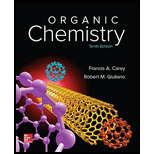
Concept explainers
Interpretation:
The adaptation of Frost's circleto generate the orbital energy level diagram is to beshown for cycloheptantrienyl cation.
Concept introduction:
The number of
These
Frost's circle is used to set up the Huckel's molecular orbitals of planar, monocyclic, and completely conjugated polyenes.
The energy levels can be superimposed on a polygon with appropriate sides with the vertex pointing down.
By inscribing a polygon having appropriate number of sides within a circle so that one of its corners lies at the bottom, each of the polygon's corners defines a
A horizontal dotted line drawn through the center of the circle separates the bonding and anti-bonding molecular orbitals.
The bonding orbitals are shown by the vertices below the halfway mark of the circle.The antibonding orbitals are shown by the vertices above the halfway mark. If the vertices lie exactly in the middle, then they represent non-bonding orbitals.
Want to see the full answer?
Check out a sample textbook solution
Chapter 12 Solutions
ORGANIC CHEMISTRY-W/ACCESS >CUSTOM<
- Which combination cannot be used as mobile phase in RPLC? A. Water-acetonitrile B. Acetonitrile-cyclopentane C. water-THF (tetrahydrofuran) D. Acetonitrile-THF (tetrahydrofuran)arrow_forwardWhat is the actual molar mass and melting point of bis(acetylacetonato)diaquanickel(II)? Show all calculations. What are the hazards associated with bis(acetylacetonato)diaquanickel(II)?arrow_forwardI am confused on how to set up this problem. Thanks much.arrow_forward
- This is about Beer-Lambert’s Law and UV-vis Spectroscopy: 1. How do you make a calibration graph?2. How do you use Beer-Lambert’s Law?3. How does the solution color relate to its absorbance spectrum?arrow_forwardIf you measured the boiling point of the solution used in Trial 4, would you predict it would havea boiling point equal to, higher than, or lower than the boiling point of pure cyclohexane?Explain your answer.arrow_forwardWhy does the methyl on the right have higher priority than the ethyl on the right when labeling the molecule as an E or Z isomer?arrow_forward
- 3. Describe how to maintain a supply of clean droppers available for use in the experiment. 4. How many spotting capillaries do you prepare for use in Part A?arrow_forwardHow would you do D, E, and G?arrow_forwardp-dihydroxybenzene and o-dihydroxybenzene can be separated by TLC using a solvent of medium polarity. The ortho isomer has a significantly higher Rf value than the para isomer. Suggest a reason for this difference in Rf values. (hint- consider the structure of these two molecules)arrow_forward
 Organic Chemistry: A Guided InquiryChemistryISBN:9780618974122Author:Andrei StraumanisPublisher:Cengage Learning
Organic Chemistry: A Guided InquiryChemistryISBN:9780618974122Author:Andrei StraumanisPublisher:Cengage Learning EBK A SMALL SCALE APPROACH TO ORGANIC LChemistryISBN:9781305446021Author:LampmanPublisher:CENGAGE LEARNING - CONSIGNMENT
EBK A SMALL SCALE APPROACH TO ORGANIC LChemistryISBN:9781305446021Author:LampmanPublisher:CENGAGE LEARNING - CONSIGNMENT

